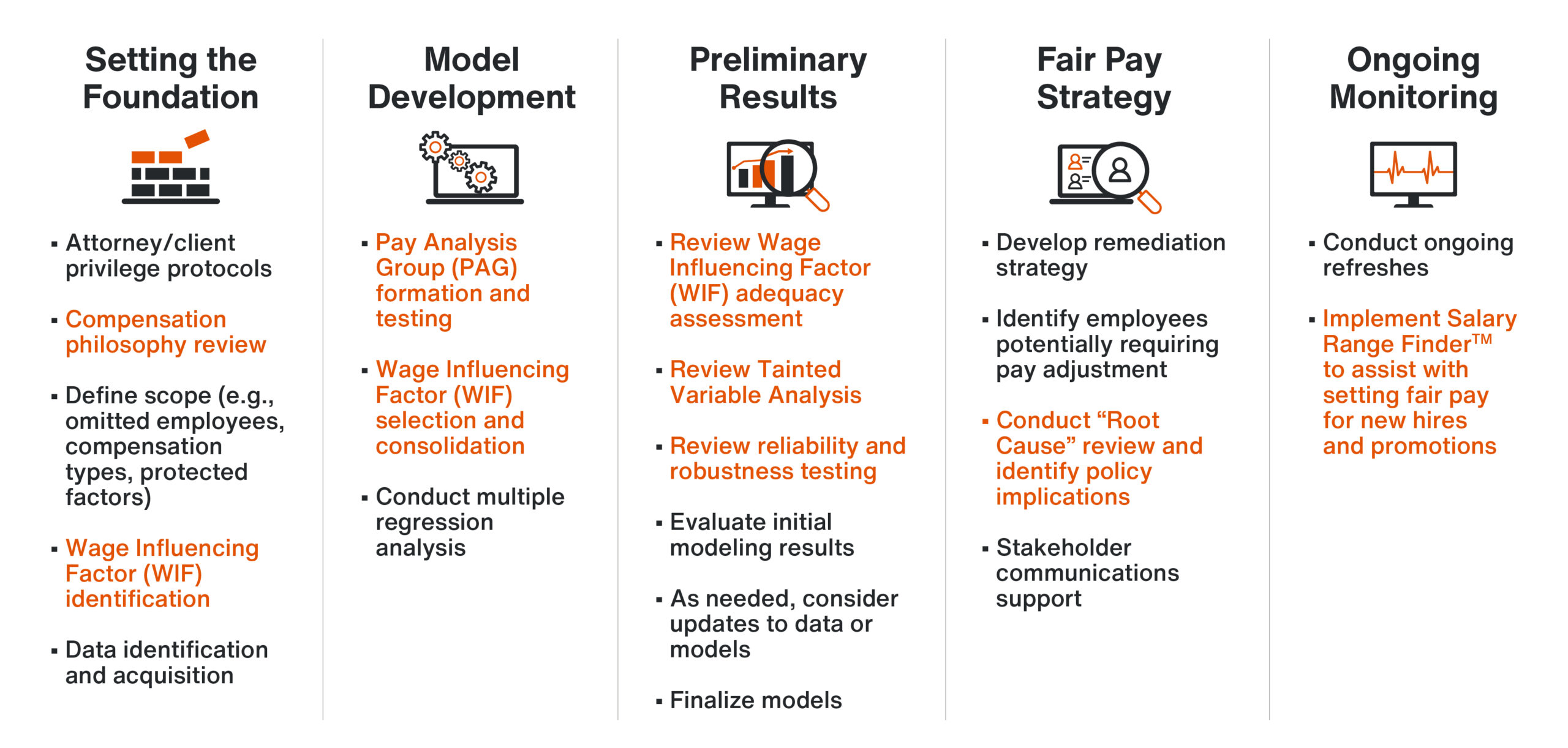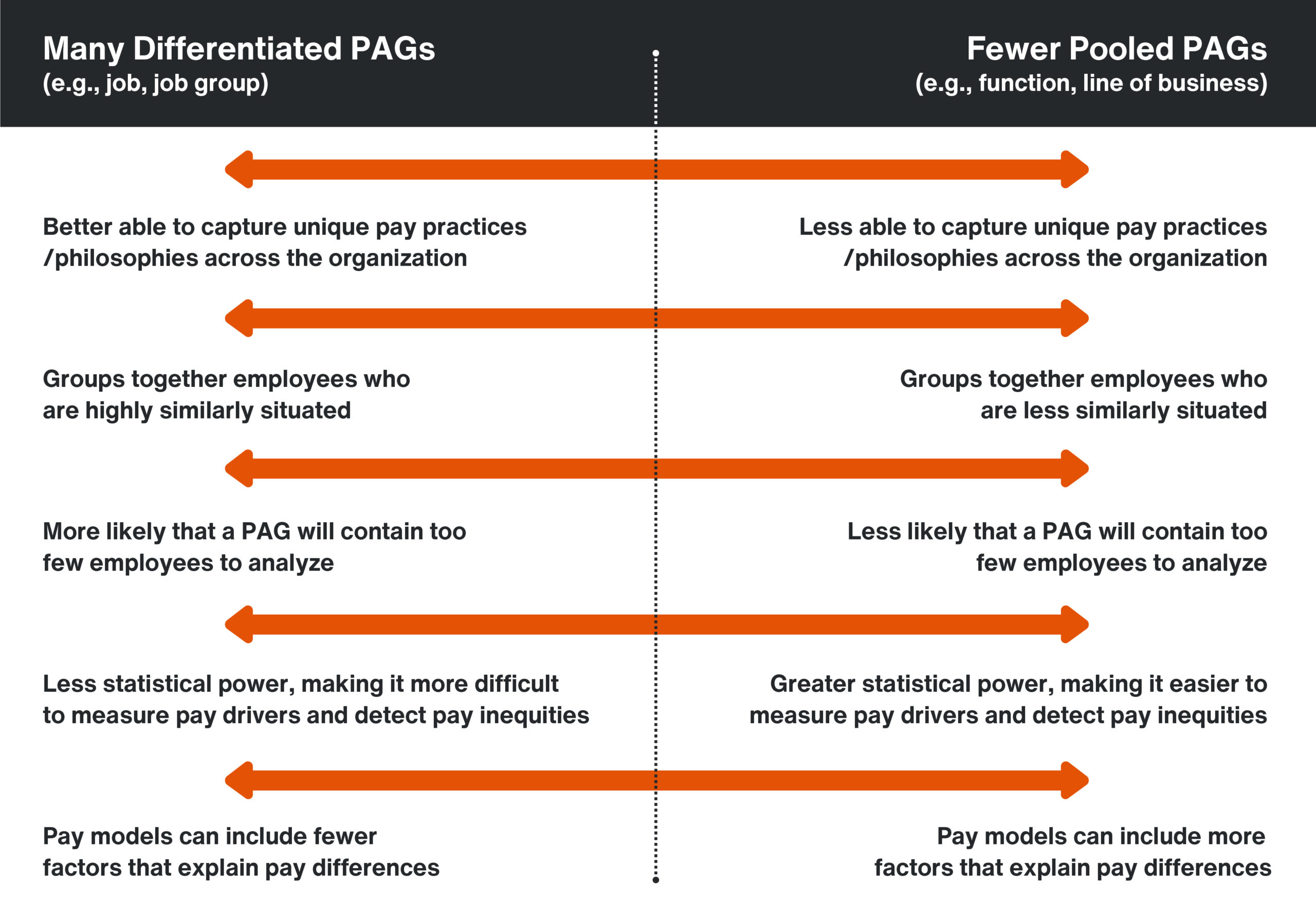Want more expert insights on the topic of pay equity? Access our entire Pay Equity Deep Dive Series.
We’re seeing more organizations take action on pay equity. According to a 2022 WorldatWork survey, 70% of participating organizations reported taking action on pay equity. This represents a ten-percentage point increase from 2019. Moreover, of those taking action on pay equity, 80% have an ongoing process for conducting a pay equity analysis. With this in mind, over the next few months, we’ll take a deep dive into the process of conducting a pay equity review.
The Concept of Pay Equity
Before we begin, it’s important to understand the concept of pay equity. Most people are familiar with the raw pay gap. The raw pay gap tells us how average or median pay differs by demographic group. For example, the UK gender pay gap report requires companies with 250+ employees to report the median pay of women compared to the median pay of men. Conceptually, the raw pay gap consists of two components:
Explained pay gap: One component reflects the extent to which pay differs by demographic group due to relevant differences in compensable factors. Such factors include occupation, career level, education, and experience. We call this the “explained” pay gap. Since this explained pay gap reflects differences across demographic groups in career level, managerial responsibility, time with the organization, performance reviews, etc., it can embody or include inequities in hiring, promotion, performance assessment, advancement, and retention. Addressing such inequities in opportunity is important but is not the focus of pay equity.
“Unexplained” pay gap: Instead, pay equity focuses on the second component of the raw pay gap. This portion of the raw pay gap is not explained by those relevant compensable differences. We call this the “unexplained” pay gap. The unexplained pay gap may be attributable to differences in gender, race/ethnicity, or another protected demographic characteristic. You may also see this pay disparity referred to as the “adjusted” or “controlled” pay gap. The objective of a pay equity review is to measure an organization’s unexplained pay gap and close it where appropriate.
Pay Equity Review Process
When conducting a pay equity review, we break down the process into five phases:
- Setting the Foundation,
- Model Development,
- Preliminary Results,
- Fair Pay Strategy,
- and Ongoing Monitoring
Each has its own set of activities. The graphic below outlines the phases and key activities. If you’ve conducted a pay equity review, you’re probably familiar with many of these activities-e.g., establishing attorney/client privilege protocols, defining the scope of the review, data acquisition and processing, conducting multiple regression analysis, developing a remediation strategy, identifying employees potentially requiring an adjustment, stakeholder communication, and conducting on-going refreshes. Others may be less familiar-e.g., compensation philosophy review; Pay Analysis Group (PAG) formation and testing; Wage Influencing Factor (WIF) identification, selection, consolidation, and assessment; Tainted Variable Analysis (TVA); reliability and robustness testing; root cause review; and Salary Range Finder® (SRF). It’s these latter activities that we’ll be focusing on in this Pay Equity Deep-Dive series. Part 1 of the series focuses on Compensation Philosophy Review and Pay Analysis Group formation and testing.

Compensation Philosophy Review
A compensation philosophy review involves developing an understanding of your organization’s compensation strategy and primary pay programs. Specifically, here are some key questions a compensation philosophy review seeks to understand:
- What are the primary objectives of your compensation strategy?
- Which employee groups are eligible for variable compensation? What percentage of pay is base vs. variable across different employee groups? To what extent is variable pay formulaic?
- How much discretion do managers have in setting pay (both base and variable)?
- Do you have sales employees, and how are they compensated?
- Does your organization have geographic differentials?
- What is your target market position? Does this differ by employee group?
Responses to these questions play an important role in guiding key decisions about your pay equity analysis. For example, which employees should be included and excluded from your analysis? What compensation types should be the focus of the analysis? How should your workforce be segmented for analysis purposes?
Sample Scenarios
Here are three sample scenarios that illustrate the importance of a compensation philosophy review:
| Scenario | Implication |
| Company’s bonus awards are formulaic and based on an employee’s base salary and career level. For example, all employees at the manager level receive a bonus that is 15% of their base salary. Managers do not have the discretion to differentiate bonus awards based on performance. | In this scenario, managers have no discretion in determining bonus awards. Thus, it’s not likely advisable to examine the equity of bonus awards directly. Instead, focus on ensuring that base salary and level placement are equitable, since these completely determine an individual’s bonus. |
| Company has both sales and non-sales employees. The primary form of compensation for their sales workforce is total target compensation (TTC). TTC is base salary plus the commission paid for meeting their sales target. The primary form of compensation for their non-sales workforce is base salary. | In this scenario, it’s advisable to run separate pay equity analyses for sales and non-sales. For sales employees, the analysis would focus on an examination of TTC. For non-sales employees, the analysis would focus on an examination of base salary. |
| Company has both union and non-union employees. Managers have discretion over the pay of their non-union workforce. Pay for their union workforce is determined by a collective bargaining agreement (CBA). The CBA was recently renegotiated and will be in effect for the next three years. | In this scenario, it may be advisable to exclude the union workforce from the pay equity analysis. Since the CBA was recently negotiated, the results of a pay equity analysis may not be actionable now. As the contract nears expiration, it may be advisable to conduct a pay equity analysis of the union workforce. The results can be used during the renegotiation process to ensure pay is fair among the union workforce. |
Pay Analysis Group (PAG) Formation & Testing
A critical foundational step in conducting a pay equity analysis is deciding how to segment your workforce. We call these segments Pay Analysis Groups (PAGs). The purpose of the PAG formation process is to group employees into meaningful pools for comparison purposes. Once your PAGs have been formed, a pay model is developed for each one. The formation of PAGs is driven by multiple considerations, including:
- Differences in pay philosophy/pay practices (e.g., commission-eligible employees vs. non-commission eligible employees),
- Nature of the work being done (e.g., functional area, line of business),
- Geographic boundaries (e.g., country, region),
- and Degree of manager latitude or discretion in setting pay (e.g., little discretion vs. considerable discretion).
The formation process needs to balance “differentiation,” which allows you to capture unique pay practices associated with different parts of your workforce, and “pooling,” which improves the statistical power of your analyses. The figure below summarizes the trade-offs associated with two different PAG creation approaches:
- Many Differentiated PAGs: Approach involves creating a larger number of PAGs, typically based on a more granular concept of the nature of work, such as job or job group.
- Fewer Pooled PAGs: Approach involves creating a smaller number of PAGs, typically based on a more aggregated concept of the nature of work, such as function or line of business.

Selecting the appropriate segmentation for your workforce requires you to balance the trade-offs above. To assist organizations with creating PAGs, Trusaic uses the compensation philosophy review to create multiple segmentations for consideration. We then conduct a series of statistical tests to identify the preferred segmentation. For example, for one organization, we evaluated the following potential segmentations:
- Job Family
- EEO-1 Job Category
- Organization Level
- Manager/Non-Manager
- Job Level
For the Job Family segmentation testing, we examined each individual job family (e.g., marketing, sales, technology, HR, finance, legal). Specifically, we investigated if each one was distinct from other job families in terms of how pay is determined. Moreover, we considered whether a job family could be combined with other job families.
We followed the same process for all the segmentation options above. From there, we compared and ranked the relative performance of the five segmentation options in terms of their ability to explain the observed variation in pay within the organization. The client then selected a final segmentation that served as the foundation for the model development phase.
* * * * * *
Stay tuned for Part 2 of our Pay Equity Deep-Dive series. We’ll talk about Wage Influencing Factor (WIF) identification, selection, consolidation, and assessment, plus reliability and robustness testing.









